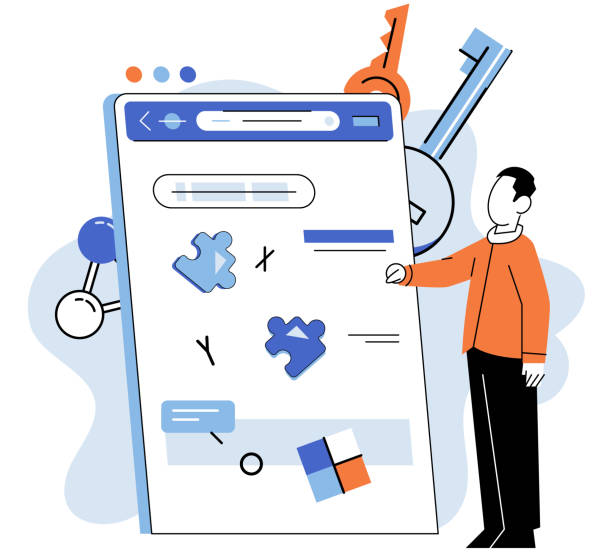The Unparalleled Importance of Fast Website Design in Today’s Digital World

In the current era where speed is paramount, fast website design is no longer a competitive advantage, but an undeniable necessity.
A website that loads slowly not only frustrates users but can also lead to lost business opportunities and a drop in search engine rankings.
Today’s users are impatient; if your website doesn’t load within a few seconds, they will most likely turn to your competitors.
This is a bitter but vital truth that is essential for every business to understand.
#WebsiteSpeed, #UserExperience, #SEO, and #IncreasedTraffic are the most important factors for the survival and success of an online business.
Research has shown that even a one-second delay in page load time can significantly impact conversion rates and customer satisfaction.
Furthermore, search engines like Google consider page load speed as an important factor in ranking websites.
Faster websites achieve better rankings and consequently attract more organic traffic.
This means greater access to potential customers and sustainable business growth.
Below, we will delve deeper into these topics to help you fully understand their importance.
Tired of losing business opportunities due to lacking a professional corporate website? Worry no more! With Rasaweb’s corporate website design services:
✅ Your brand’s credibility and professionalism will increase.
✅ You will attract more customers and sales leads.
⚡ Get a free consultation right now to start!
Fundamental Principles of Website Speed Optimization

To achieve a high-speed website, it is necessary to meticulously apply optimization principles and techniques.
These principles include a set of technical and design measures, all aimed at reducing load time and increasing site performance.
One of the most important of these principles is image optimization.
High-volume images can severely reduce site speed; therefore, using appropriate formats (like WebP) and compressing them without losing quality is crucial.
Additionally, using Content Delivery Networks (CDN) to distribute static content from servers closer to the user can dramatically improve response time.
#ReducedLoadTime, #Compression, #Caching, and #Minification are among the principles that play a key role in fast website design.
Browser caching also helps users view the site faster on subsequent visits, as parts of the content are stored in their temporary memory.
Furthermore, Minification or compression of CSS, JavaScript, and HTML codes by removing whitespace and unnecessary characters reduces file size and increases load speed.
Choosing a suitable and high-speed hosting also plays an undeniable role in this process; inappropriate hosting can nullify all your optimization efforts.
These measures, combined, provide a robust structure for a high-speed website.
The Impact of Fast Website Design on SEO and User Experience

The connection between fast website design and SEO (Search Engine Optimization) is no secret.
Google and other search engines consider page load speed as one of the important factors in ranking web pages.
Slower websites achieve lower rankings in search results, which means less visibility and lower organic traffic.
Conversely, a high-speed site not only attracts more users but, due to a better user experience, will have a lower bounce rate and users will spend more time on the site.
These factors directly positively impact the site’s credibility with search engines.
#GoogleRank, #BounceRate, #CustomerSatisfaction, and #SiteCredibility are metrics directly affected by fast website design.
An optimized user experience not only increases user retention on the site but also improves conversion rates.
Suppose you have an online store; if customers cannot view products or complete the purchase process due to slow website speed, you will undoubtedly lose sales.
A fast site conveys a sense of trust and professionalism, assuring customers that they can easily and without wasting time access the information they need.
This positive cycle leads to increased customer loyalty and, ultimately, sustainable business growth.
To better understand this impact, refer to the table below:
| Factor | Impact of High Speed | Impact of Low Speed |
|---|---|---|
| SEO Ranking | Increased Ranking | Decreased Ranking |
| User Experience | High Satisfaction | Dissatisfaction and Exit |
| Bounce Rate | Significant Decrease | Significant Increase |
| Conversion Rate | Significant Improvement | Sharp Decline |
| Brand Credibility | Increased Trust | Decreased Credibility |
Advanced Tools and Techniques for Fast Website Design

To achieve the goal of fast website design, there is a set of advanced tools and techniques that developers and website managers can leverage.
Using CDN (Content Delivery Network) is one of the most effective methods.
By distributing your site’s content across various geographical servers, CDN ensures that users access content from the closest possible server, drastically reducing load time.
Furthermore, compression techniques like Gzip for text files and advanced image optimization (e.g., using tools like ImageOptim or CDN services that perform image optimization) minimize the volume of data sent.
#CDN, #ImageCompression, #BrowserCache, and #LazyLoading are vital tools for improving web page speed.
Implementing Lazy Loading for images and videos also means that media content is only loaded when the user scrolls to that section of the page, not from the very beginning.
This significantly reduces the initial page load.
Utilizing server-side caching services (like Varnish or Redis) and browser-side caching are other key techniques that eliminate the need for frequent server requests by temporarily storing data.
These measures, coupled with clean and optimized code, form the main pillars of a high-speed website and significantly enhance the user experience.
Are you worried your company’s old website might drive new customers away? Rasaweb solves this problem with modern and efficient corporate website design.
✅ It increases your brand’s credibility.
✅ It helps attract targeted customers.
⚡ Contact Rasaweb for a free consultation!
The Role of Optimized Coding in Achieving Fast Website Design

The core of every fast website is optimized and efficient coding.
Fast website design is not limited to external tools and techniques but requires deep attention to how codes are written and project architecture.
HTML, CSS, and JavaScript codes should be as lightweight and optimized as possible.
Removing unnecessary code, comments, and whitespace (Minification) in CSS and JS files drastically reduces their size and speeds up load time.
Also, carefully using JavaScript scripts and loading them asynchronously prevents page rendering from being blocked.
#CleanCoding, #JavaScript, #CSS, and #DatabaseOptimization are important points that play a role in accelerating website performance.
Furthermore, optimizing database queries and ensuring they execute in the shortest possible time is crucial for dynamic websites.
Using external CSS and JavaScript, rather than inline, allows the browser to cache them, eliminating the need for re-loading on subsequent visits.
Choosing lightweight and optimized frameworks and libraries is also very important in this process; using heavy frameworks without real need can harm website speed.
Adhering to these principles during the coding phase lays the foundation for an optimized and high-speed website.
Server and Hosting Optimization for Greater Speed

One of the fundamental factors in fast website design is the selection and optimization of server and hosting infrastructure.
Even with excellent coding and front-end optimizations, if your server is slow or unsuitable, all efforts will be futile.
Choosing a reputable hosting provider that aligns with your site’s traffic and resource needs is crucial.
Inexpensive shared hosting might be tempting initially, but they usually have limited resources, and their performance severely degrades with increased traffic.
In contrast, Virtual Private Servers (VPS), dedicated servers, or cloud hosting solutions offer greater flexibility and power for managing resources and high traffic.
#HostSelection, #Database, #HTTP/2, and #SufficientRAM are factors that must be considered.
Correct server configuration, using the latest versions of server software like PHP and web servers such as Nginx or Apache, and optimizing the database (like MySQL or PostgreSQL) also play a significant role.
Ensuring that the server has sufficient RAM and CPU to handle requests and process data is essential for maintaining site speed under high traffic conditions.
Implementing the HTTP/2 protocol can also significantly improve load speed due to its ability to multiplex requests and compress headers.
The combination of these factors leads to a very fast and reliable website.
Why Fast Mobile Website Design is Essential?

Given the growing statistics of mobile device usage for internet access, fast website design and its optimization for mobile is no longer an option, but a necessity.
Google has adopted mobile-first indexing for years, meaning your site’s mobile version is the primary criterion for its ranking in search results.
If your site is slow on mobile, even if it has high speed on desktop, it can severely impact your SEO ranking.
Mobile users are typically on the go with varying internet connections, so a slow site can quickly disappoint them.
#MobileFriendly, #AMP, #PWA, and #MobileUserExperience are of particular importance.
Using technologies like AMP (Accelerated Mobile Pages) or PWA (Progressive Web Apps) can significantly increase site load speed on mobile devices.
AMP provides a very fast user experience by offering a lightweight and simplified version of web pages, while PWA offers native-app-like capabilities, including offline access and notifications.
Responsive optimization and ensuring your site displays correctly and quickly across various screen sizes are also very important.
To better understand the difference in load speed between desktop and mobile, refer to the table below:
| Metric | Desktop | Mobile | Why is there a difference? |
|---|---|---|---|
| Recommended Load Time | Under 3 seconds | Under 2 seconds | More limited internet connection, weaker processor on mobile |
| SEO Importance | Very Important | Extremely Important (Mobile-First) | Google primarily indexes the mobile version |
| Influencing Factors | Images, scripts, hosting | Same, plus responsiveness, AMP/PWA | Need for specific optimization for smaller screens |
| Bounce Rate | Increases if slow | Increases sharply if slow | Less patience from mobile users |
Common Mistakes in Website Design and Ways to Avoid Them

On the path to fast website design, there are some common mistakes that can render all efforts fruitless.
Recognizing these mistakes and finding appropriate solutions for them is a crucial step towards improving site performance.
One of the biggest mistakes is using very high-volume images without optimization.
These images can be hundreds of kilobytes or even megabytes in size and severely slow down page loading.
The solution is to always optimize images before uploading, use modern formats like WebP, and implement Lazy Loading.
#LargeFiles, #ExcessiveScripts, #WeakHosting, and #CodingWeaknesses are among the issues that require special attention.
Another mistake is loading too many unnecessary JavaScript scripts or CSS files, each requiring separate HTTP requests, which increases load time.
Optimizing and Minifying these files, and merging them if possible, can help with this problem.
Lack of caching, both server-side and browser-side, is also a common mistake that causes all content to be reloaded every time a user visits your site.
Choosing inappropriate hosting and not optimizing the database can also severely reduce site speed.
By avoiding these mistakes and implementing the solutions provided, one can achieve fast and efficient web design.
Did you know that your company’s website is the first point of contact for 75% of potential customers?
Your website is the face of your brand. With **Rasaweb**’s corporate website design services, build an online presence that earns customer trust.
✅ Create a professional and lasting image for your brand
✅ Attract target customers and increase online credibility
⚡ Get a free consultation from **Rasaweb** experts!
Measuring and Monitoring Your Website Speed

After implementing all optimization techniques for fast website design, the next step is continuous measurement and monitoring of website speed.
This ensures that the changes made have been effective and also helps identify potential new weaknesses.
Many free and powerful tools are available for this purpose.
Google PageSpeed Insights is one of the most popular, providing a score from 0 to 100 for your site’s speed on desktop and mobile, and offering suggestions for performance improvement.
GTmetrix and WebPageTest are other tools that provide more detailed information on load time, number of requests, and the performance of each page component.
#GooglePageSpeed, #GTmetrix, #CoreWebVitals, and #Lighthouse are among the essential tools for analyzing and measuring site speed.
In addition to these tools, familiarity with Google’s Core Web Vitals (including Largest Contentful Paint, First Input Delay, and Cumulative Layout Shift), which are real user experience metrics, is crucial.
These metrics directly impact your site’s SEO ranking.
Regular monitoring of these metrics and striving to improve them significantly helps maintain and enhance your site’s speed.
Using Application Performance Monitoring (APM) tools can also help identify server-side and database issues, ultimately leading to a faster and more stable website.
The Future of Fast Website Design and Upcoming Trends

The world of the web is constantly evolving, and fast website design is no exception.
The future of high-speed websites is being shaped by new trends that further enhance user experiences.
One of these trends is the advancement of AI and machine learning in automated website optimization.
Intelligent systems can automatically optimize images, remove unnecessary code, and even implement the best caching strategies.
This significantly lightens the burden on developers and allows for unprecedented speeds.
#AI, #Web3, #ImmersiveUserExperience, and #CloudComputing are trends shaping the future of fast website design.
Furthermore, the emergence of Web 3.0 and decentralized technologies can help distribute content and processes more efficiently, improving speed at deeper layers of the web.
Increased use of cloud computing and serverless architectures also allows developers to focus on coding and optimization without worrying about complex infrastructures.
Ultimately, focusing on immersive and rich user experiences, which require fast loading of interactive and 3D content, will drive developers towards further innovations in speed.
These trends indicate that the future of the web will not only be faster but also smarter and more interactive.
Frequently Asked Questions
| Row | Question | Answer |
|---|---|---|
| 1 | What does fast website design mean? | Fast website design means optimizing website design and development processes so that the final result (the website) is ready for use in the shortest possible time, while maintaining quality and efficiency. This includes using efficient tools, templates, and techniques. |
| 2 | Why is speed important in website design? | Speed in website design is important because customers typically have an immediate need for an online presence. Additionally, longer projects can be more costly and delay business opportunities. Faster website delivery contributes to customer satisfaction and a competitive advantage. |
| 3 | What tools help with fast website design? | Content Management Systems (CMS) like WordPress, Joomla, or Drupal, the use of CSS frameworks like Bootstrap or Tailwind CSS, page builders like Elementor or Visual Composer, and Rapid Application Development (RAD) tools help with fast design. |
| 4 | Does using pre-made templates affect fast design? | Yes, using ready-made and standard templates has a significant impact on fast design. These templates are pre-designed and only require customization of content, color schemes, and images, which drastically reduces development time. |
| 5 | What is the role of CMS (Content Management System) in fast website design? | CMSs play a key role in accelerating the website design and development process due to providing a graphical user interface, eliminating the need for deep coding for most operations, the availability of ready-made plugins and templates, and easy content editing capabilities. |
| 6 | Does high design speed reduce the final website quality? | Not necessarily. If standard and optimized methods, tools, and templates are used, a high-quality website can be designed in a short time. The knowledge and experience of the design team are also very effective in maintaining quality. |
| 7 | What tips are important for speeding up the client communication process in website design? | Having a clear and defined process for requirements gathering, using standard forms for content submission, setting realistic deadlines, and holding focused and efficient meetings can accelerate client communication. |
| 8 | What is the impact of image optimization on website load speed after design? | Image optimization (volume compression, using appropriate formats like WebP) reduces the overall size of website pages. This size reduction helps browsers download and display pages faster, which improves user experience. |
| 9 | Is suitable hosting effective in the final speed of the website after design? | Yes, high-quality hosting, powerful servers, sufficient resources, and adequate bandwidth play a very important role in website load speed after design. Even an optimized website will perform slowly on weak hosting. |
| 10 | For what types of businesses is fast website design most suitable? | Fast website design is very suitable for small and medium-sized businesses, startups, nascent online stores, bloggers, or individuals who need an immediate and low-cost online presence. This method allows them to enter the market faster and receive feedback. |
And other services of Rasaweb Advertising Agency in the field of advertising
Smart Marketplace: An effective tool for user interaction through attractive UI design.
Smart Sales Automation: A specialized service for increasing website traffic growth based on attractive UI design.
Smart Data Analysis: An innovative platform for improving user interaction with custom programming.
Smart Advertising Campaign: Professional optimization for user engagement using precise audience targeting.
Smart Google Ads: Professional optimization for online growth using marketing automation.
And over a hundred other services in the fields of internet advertising, advertising consulting, and organizational solutions
Internet Advertising | Advertising Strategy | Sponsored Content
Resources
Fast Website DesignOnline Business GrowthEfficient Website TipsSEO Guide for Success
? Rasaweb Afarin Digital Marketing Agency, your reliable partner on the path to online growth!
For more information about our professional services, including WordPress website design, we are ready to elevate your business to new heights.
📍 Tehran, Mirdamad Street, next to Bank Markazi, Southern Kazeroon Alley, Ramin Alley, No. 6



